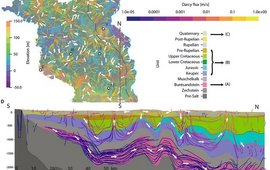The focus of our research in Section 4.5 is on geodynamic processes of sedimentary basins in different plate tectonic environments. In particular, we study the dynamics of these basins today and over geological time. To this end, we integrate multidisciplinary geoscientific observations into three-dimensional models that represent the heterogeneous distribution of physical properties in the subsurface. These models are the basis for simulations of coupled processes such as heat and fluid transport in the subsurface. For example, we can derive predictions of how warm it is where at what depth and why? By combining observations with simulation techniques, we create digital twins of the geological subsurface to which "what if?" questions can be addressed.
Such results are very useful to answer applied scientific questions such as the safe and sustainable use of groundwater, extraction of deep geothermal energy or long-term storage of materials. It is particularly helpful that sedimentary basins are depositional environments that record geologic history. They cover large areas of the Earth's surface of both continents and oceans. Most of our geo-resources on Earth are tied up in these geologic structures. Sedimentary basins are of societal importance as, among other things, places that contain our water, are suitable for geothermal energy use or storage, and also host fossil resources such as coal, oil, and natural gas.
Questions we are exploring include:
- What controls deformation at different scales? Which effects are related to structure and which forcings control which processes?
- How would surface processes as for example global warming or a glaciation affect these basins?
- Why and how do continents break apart, and what structures form at the margins of the newly forming oceans, such as at the passive continental margins of the Atlantic?
- What characterizes mountain building and the associated foreland basins such as in the Alps and the Argentine Andes?
- How can the geological subsurface be used sustainably and safely, such as to develop the geothermal potential of major cities?
- What is for example the structure of the intracontinental North German Basin today and how are temperature and pressure distributed in its interior? The deformation of this basin has been significantly influenced over the period of the last approximately 250 million years by the Zechstein salt it contains. This salt was mobilized over time and is distributed today as a large number of salt pillows; salt walls and salt diapirs. Since salt is thermally very conductive and impervious, it also decisively influences the deep temperature distribution in the subsurface today.


![[Translate to English:] 3D Modellierung](/fileadmin/_processed_/d/c/csm_basin_a6d90c22a0.jpeg)
![[Translate to English:] 3D Modellierung](/fileadmin/_processed_/8/b/csm_figure_4_website_779bb82a24.jpeg)
![[Translate to English:] 3D Modellierung](/fileadmin/_processed_/1/2/csm_GrsBK_hybrid_6b8f7c8935.png)
![[Translate to English:] 3D Modellierung](/fileadmin/_processed_/8/8/csm_Salt_4614314590.jpeg)
![[Translate to English:] 3D Modellierung](/fileadmin/_processed_/4/9/csm_Isotherm_9f5d7f9ca1.jpeg)


![[Translate to English:] Rauchender Kopf](/fileadmin/_processed_/b/a/csm_Publikationen_Image_b1f75da220.jpeg)

